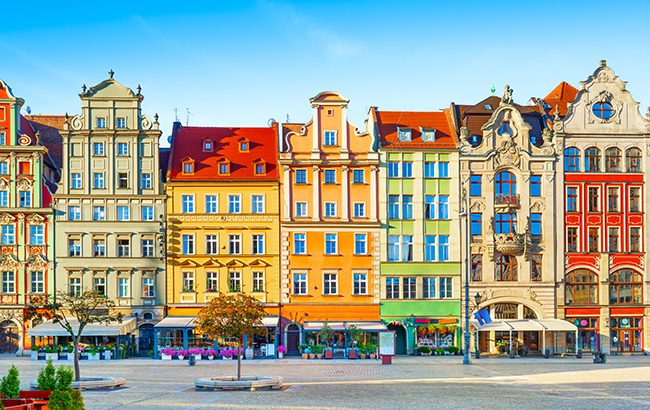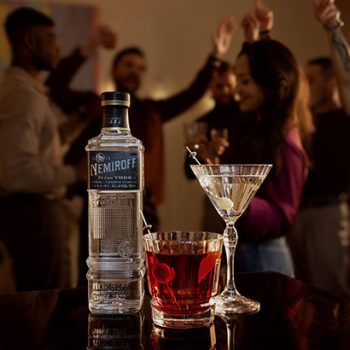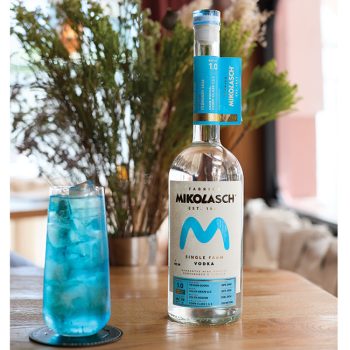Spirits pivot in troubled Eastern Europe
By Melita KielyDespite the region being destabilised by Russia’s war on Ukraine, producers are confident about future success.

*This feature was originally published in the April 2025 issue of The Spirits Business magazine.
“Illiberal regimes; marionette institutions; raging, unchecked oligarchy; and silenced civil societies.” Those were risks recently highlighted in an article about geopolitical tensions in Eastern Europe on the website of the European Council on Foreign Relations (ecfr.eu). The Russia-Ukraine war has troubled the region since 2022. With a tense meeting between the new president of the US, Donald Trump, and Volodymyr Zelenskyy, the president of Ukraine, in February, Europe’s security landscape has come under new questioning.
Many brands have pulled out of Russia since the war in Ukraine started, including Diageo. “Winding down our operations in Russia, our biggest market, was a big decision but the right one for us,” explains Michael Holm, managing director Eastern Europe, Diageo. “We’ve also had to navigate volatility and difficult decisions in the Middle East and Central Asia. We try to be as fact-based and clear as possible, and we typically communicate frequently to stay close to employees, customers and authorities. Through such periods of volatility, we also do our best to display the values of our company and to support customers and employees wherever we can.”
But what impact is the Russia-Ukraine conflict having – or could it have – on the spirits industry in Eastern European countries? IWSR Drinks Market Analysis cites the top five spirits categories in Eastern Europe to be vodka, brandy (excluding Cognac and Armagnac), fruit eaux-de-vie, liqueurs, and Scotch whisky. For these statistics, IWSR includes Estonia, Latvia, Lithuania, Poland, Czech Republic, Slovakia, Hungary, Bulgaria, Romania, Serbia, Slovenia, Croatia, Bosnia and Herzegovina, Kosovo, Albania, Montenegro, North Macedonia, Belarus, Moldova, and Ukraine in Eastern Europe.
Vodka, the biggest-selling category, experienced a 1% decline in volume between 2022 and 2023, and fell by a compound annual growth rate (CAGR) of 3% between 2018 and 2023. From 2023 to 2028, it is expected to be stagnant, with 0% CAGR volume growth.
Nemiroff is well on its way to recovery, after the Ukrainian vodka suffered substantial sales falls in the wake of the Russia-Ukraine war. In 2024, the company closed the year with 18.1% volume sales growth globally. “This past year has been a defining period for Nemiroff in Eastern Europe, marked by both challenges and significant achievements,” says Yuriy Sorochynskiy, CEO of Nemiroff.

“In the Baltics, we secured listings in major retailers, successfully navigating intense price competition. Poland saw strong activations in discount retail, while Romania and Bulgaria presented contrasting dynamics – one experiencing volatility, the other showing growth in premium sales. The Czech Republic stood out, with record-breaking results, driven by the success of both our Originals and De Luxe ranges. Meanwhile, we are actively expanding in Hungary, Slovakia, and Croatia, reinforcing our market leadership.”
An essential market
There’s competition from fellow Ukrainian vodka Mikolasch, which was acquired by Origen X in 2024. Eastern Europe is an “essential” market for the brand “as it’s deeply rooted in Ukrainian heritage and authenticity, making the region both a brand origin and natural growth market”, says Zak Oganian, CEO of Origen X. “There is tangible opportunity for Mikolasch to become the number-one premium global Ukrainian brand, and Eastern Europe is a key market, as far as early adopters are concerned. For example, Polish vodka drinkers appreciate high-quality Ukrainian vodka more than local Polish products, but there is very little on offer as far as consistent, high-quality Ukrainian brands are concerned.”
Value, authenticity, traceability, and price are top priorities for vodka drinkers in Eastern Europe, Oganian notes. While he sees some national loyalty to local labels at the value end of the category, for premium-plus brands, authenticity and transparency “still dominate”.
Trading up in the region is tricky, though, as IWSR highlights. A Balkan expert notes how consumers in the market “would like to trade up but most currently can’t afford to”. Meanwhile, an IWSR expert covering Romania, Moldova and Ukraine, highlights: “Value for money remains important to more conservative, older consumers. When younger consumers trade up, they compensate by consuming less often and spending less per occasion.”

This example of moderation has also been observed by Diageo’s Holm. “It’s increasingly becoming a lifestyle choice for many consumers who seek to balance indulgence with wellbeing,” he explains. “This shift is driven by a greater awareness of health and wellness, as well as a desire for new drinking experiences. It’s important to note that consumers may change their drinking habits, but they will not stop celebrating, and our brands will continue to play a role in celebrations worldwide.”
Holm continues to highlight just how exciting Eastern Europe is as a market, despite the geopolitical uncertainty in the region. The potential is huge, he says. “As for Eastern Europe, we are the fastest-growing market on the continent, and we are confident about the strong potential of this region,” Holm says. “We are in a strong position, and long-term trends are in our favour.”
Premiumisation is still driving value growth in an overall slowing spirits market. Ultimately, consumers are enjoying quality over quantity. Eastern Europe is dominated by mainstream price-tier brands, but premium offerings like Captain Morgan, Johnnie Walker, Smirnoff and Baileys are helping to fuel demand for more high-end brands in Diageo’s portfolio, such as Don Julio Tequila, The Singleton Scotch whisky, and Zacapa rum. “Luxury grows twice as fast in our region as it does globally – and it presents a big opportunity that we are investing in,” Holm adds.
Vodka still dominates
Nemiroff’s Sorochynskiy has seen competition from whisky, brandy, bitters and apéritifs grow, even though vodka is “still the dominant spirit in Eastern Europe”. IWSR data supports this. Scotch whisky delivered strong year-on-year (YOY) growth (8%) between 2022 and 2023, but is forecast to grow at a slower CAGR of 2% between 2023 and 2028. Brandy (excluding Cognac and Armagnac) experienced a 6% YOY increase from 2022 to 2023, but a CAGR of 0% between 2018 to 2023. This is forecast to remain the same between 2023 and 2028.
Younger consumers, Sorochynskiy says, are keen to explore more “diverse flavour profiles”. IWSR’s Balkan expert also sees this trend developing: “The biggest opportunity (barring agave, where volumes are growing fast but the absolute amount remains marginal to the total market size) would be in bitters and spirit apéritifs. These are benefiting from the growth of the apéritif occasion and strong local products.”
In Romania, Moldova and Ukraine, the picture looks pretty similar, as IWSR’s spokesperson there says: “The biggest opportunity is the willingness of Gen Z and younger millennials to try imported, more expensive drinks (standard and above).”
For Origen X, having a portfolio of brands – which also includes Kinahan’s Irish whiskey and Bagots Irish whiskey – that offer affordable entry-level products and more expensive premium bottlings positions it well to tap into varying demands in Eastern Europe. Oganian notices the shift towards premium products particularly in urban centres among Gen Z and Millennial consumers. “Value remains dominant in rural areas and in mass-market retail,” he explains. “There are very sensitive price-bracket borders for the ‘premium, but affordable category’, which, if breached, can take a brand outside of major consumer-access areas that are based on purchasing power and risk-aversion, mostly.”

He adds: “Usually it is one or the other: either affordable price and no heritage and low quality, or high price and a lot of heritage and quality. It is rare that brands can do both. Origen X’s strategy is dual: maintain strong value offerings, while introducing premium lines in aspirational, targeted segments. Premiumisation is happening, but selectively, so success depends on smart market segmentation and localised execution.”
Nemiroff’s Sorochynskiy also shares a similar notion. He notes how in Poland, for example, local brands account for more than 90% of market share. Meanwhile, in the Baltic states, imported brands hold a more significant share of 30%-40%. However, he adds: “Each year, we observe a 1%-3% increase in imported vodka sales, signalling growing demand for more exclusive, high-quality offerings.”
In a region riddled with ongoing geopolitical tensions, it’s encouraging to hear how opportunity-rich the spirits industry is in Eastern Europe. For Origen X’s Oganian, the next 12 months will be “gradual but steady, given market saturation, with premium spirits gaining more share in higher-income pockets”.
He adds: “Brands with strong stories, clear provenance, and local engagement – like Mikolasch, Kinahan’s and Bagots – are well-positioned to outperform. Consumer purchasing power, as well as a more positive consumer outlook, is growing in Eastern Europe, according to most of the data, which is not quite the case in the Western world at the moment, although also likely to be temporary.”
If brands can withstand the current political and economic pressures, Eastern Europe could develop into a very lucrative market for several spirits categories. As Diageo’s Holm notes: “Our confidence in the mid- to long-term remains high.”
Related news
Amber Beverage names new Eastern Europe distributors
Eastern Europe: Affordability 'biggest barrier' to recruiting new drinkers
